Ben Balas
- Problem Set #1
|
Part 1
|
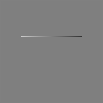 p1.dbn p1.dbn |
paper 50
repeat a 20 80
{
set [a 65] a
}
|
| |
Create a program to draw a carefully chosen one line on a paper of your choice.
|
Part 2
|
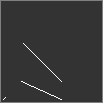 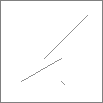 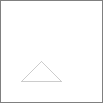 p2.dbn p2.dbn |
paper 0
set a 20
pen a
line a a (2*a) (2*a)
line (20+a) (60-a) 60 20
line 20 20 60 a
|
| |
Create a program that uses one variable as a means to control a set of 3 lines. Capture 3 instances of the graphic (A,B,C).
|
Part 3
|
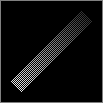 p3.dbn p3.dbn |
paper 100
repeat a 10 80
{
pen a
line a (a+10) (a+10) a
}
|
| |
Create a program to draw a single filled rectangle. Again, choose carefully.
|
Part 4
|
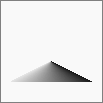 p4.dbn p4.dbn |
paper 2
repeat a 10 90
{
pen a
line 50 40 a 20
}
|
| |
Create a program to draw a single filled triangle. Use your good judgement.
|
Part 5
|
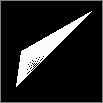 p5.dbn p5.dbn |
paper 100
pen 1
repeat a 15 90
{
line a a 20 50
}
|
| |
Think of all the ways you can draw a filled triangle, and choose one. Utilize the properties of the drawing method you choose, to create a single filled triangle.
|
Part 6
|
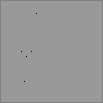 p6.dbn p6.dbn |
paper 40
set [20 50] 100
set [30 50] 100
set [25 45] 100
set [23 20] 100
set [35 88] 100
|
| |
Set 5 dots on a paper of your choice. Evoke an emotion with your choice in placement of dots.
|
Part 7
|
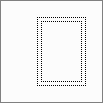 p7.dbn p7.dbn |
paper 1
repeat a 20 40
{
set [(2*a) 20] 100
set [(2*a) 80] 100
}
repeat a 10 40
{
set [40 (2*a)] 100
set [80 (2*a)] 100
}
repeat a 18 42
{
set [(2*a) 16] 100
set [(2*a) 84] 100
}
repeat a 8 42
{
set [36 (2*a)] 100
set [84 (2*a)] 100
}
|
| |
Create a representational picture (i.e. something that looks like something) using just 8 (at maximum) dotted lines.
|
Part 8
|
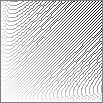 p8.dbn p8.dbn |
paper 1
repeat a 1 100
{
repeat b 1 100
{
set [(a*a/b) (b*b/a)] ((a+b)/2)
}
}
|
| |
Using a nested loop, fill the entire field with the value of some calculation that can be appreciated. Do not use the Line command.
|
Part 9
|
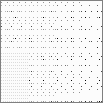 p9.dbn p9.dbn |
paper 1
repeat a 0 13
{
repeat b 0 16
{
repeat c 0 7
{
set [(2*a*c) (3*b*c)] (c*14)
}
}
}
|
| |
Using a nested loop, create a stippled pattern of dots that can be enjoyed for its complexity. Do not use the Line command.
|
Part 10
|
 p10.dbn p10.dbn |
paper 1
repeat a 0 50
{
repeat b 0 50
{
pen ((a+b)/2)
line a b (2*a) (2*b)
}
}
|
| |
Using the Line command, and a (few) nested loop, create an image that evokes a three-dimensional feeling through shading.
|
 p1.dbn
p1.dbn 

 p2.dbn
p2.dbn  p3.dbn
p3.dbn  p4.dbn
p4.dbn  p5.dbn
p5.dbn  p6.dbn
p6.dbn  p7.dbn
p7.dbn  p8.dbn
p8.dbn  p9.dbn
p9.dbn  p10.dbn
p10.dbn